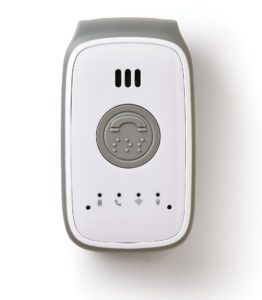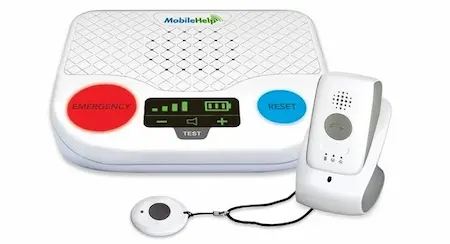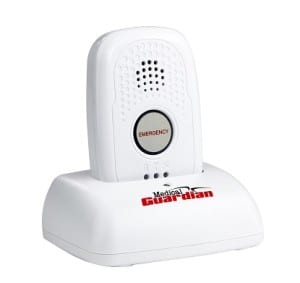Last Updated on September 4, 2020

What is a Mobile Alert System?
A mobile alert system typically consist of 3 parts:
- a main cellular emergency help button device with speakerphone that connects users to monitoring help
- access to 24/7 alerts monitoring personnel for help
- supplemental accessories, features, apps that either support the portable device or expand on system capabilities
They are also referred to as mobile medical alert systems, mobile personal emergency response systems (MPERS). These mobile systems typically include GPS tracking and fall detection. Examples of these systems include the all-in-one mobile alert, duo in-home and mobile alert and cellular mobile device with pendant.
Key Features of Mobile Alert Systems and Devices
GPS – The GPS tracking allows for caregivers and the senior’s children to keep tabs on the physical location of their loved ones. For elderly patients of mild cognitive impairment, Alzheimers, dementia, GPS tracking is important in case the elderly user has wandered off and lost their way. It also helps emergency personnel to have the user’s GPS location in cases the user is unable to verbalize his or her location. In an emergency, time is of the essence.
There is a slight chance that the mobile device you come across does not have GPS locations tracking. If it’s not obviously stated, check further into the medical alert company’s website or call them to find out.
Cellular Connection – No home or cell phone line is needed. These are cellular mobile alert devices that come with their own phone connection. There is no need to maintain a home telephone line subscription just to access personal emergency response monitoring services. It does not matter if you have a separate cellular phone line or not. These devices must still use their own built-in phone connection.
Water Resistance – This is important in scenarios where the senior citizen gets incapacitated in a bathroom. The level of water resistance in these devices can vary. Most will not work in swimming pools, but many will stay functional even after getting wet in the shower or bath.
Automatic Fall Detection – Falls are one of the most common causes of injuries or worse in the senior population. Automatic fall detection sensors are able to tell if the user has fallen and automatically send out mobile alerts to the emergency call center. Many mobile devices are fall detection units, and the service can be turned on whenever it’s needed (at an added cost).
Let’s take a look at the main types of mobile medical alert systems with GPS.
Main Types of Mobile Alert Systems
1. All-in-One Mobile GPS Alert Device System

System Equipment: Cellular Mobile GPS Help Button Device, Charging Dock
These small cellular mobile alert devices come equipped with a help button that will allow its user to send an alert for help. The entire system consists of a small wearable mobile help button device and a charging dock. The mobile device is light enough to be worn with a necklace lanyard by its user. It works anywhere there is good cellular network connectivity.
An all-in-one mobile alert device is easy to understand and use. All the user has to do is to press the help button in case of emergency. Once pressed, an emergency operator will answer the call. The senior user can speak directly into their pendant as it contains a speaker and microphone.
These mobile alert devices come equipped with GPS trackers so that authorized caregivers and family members are able to track the user’s location. Should the user be unable to respond, the GPS tracker will allow the emergencies monitoring personnel to determine the user’s location. The newer versions of these mobile alert devices include Wifi positioning, in addition to GPS (learn more). This improves on the accuracy in determining the location of the device.
The personnel handling the call are trained to follow-through with a set of safety procedures. Sometimes, it involves calling the senior’s adult child or local police to check-in with the user. The user can also indicate their preferences to a company representative when they initially set up their account.
All-in-one mobile systems are available through LifeStation and Medical Guardian.
2. Two-in-One Separate In-Home Medical Alert Console and Portable Mobile GPS Device System

System Equipment: Cellular In-Home Console, Cellular Mobile GPS Device, Help Button (Necklace Pendant/Wristband)
In contrast to the all-in-one mobile alert device system, the two-in-one duo system comes with two separate speaker devices: an in-home medical alert console unit that can be strategically placed inside your house, and a portable cellular GPS device that senior users can bring along with them whenever they go out. Like all-in-one single piece devices described above, this two-in-one system can be used to call emergency personnel if the user feels incapacitated.
The system comes with a wireless necklace pendant or wristband that is worn by the user. An emergency call can be activated through the in-home console or portable unit with just a press of a button.
When the user leaves home, the mobile medical alert device can be taken along by the user in his or her belt pouch or purse. The device comes with an emergency help button, speaker, microphone and GPS tracker. It’s optional whether the user wants to wear a separate alert pendant. It will send out emergency alerts directly through a cellular phone network.
Duo in-home mobile alert systems are available through MobileHelp and Lifefone. These systems are produced by MobileHelp. It’s available through them directly or from other select medical alert companies like Lifefone.
3. Portable Mobile Alert GPS Device Paired With Wearable Water-Resistant Help Button

System Equipment: Cellular Mobile GPS Device, Help Button (Necklace Pendant/Wristband)
The single cellular device mobile medical alert system is a simplified version of the two-in-one Duo system described above. A single cellular mobile alert device is used as the central emergency calls connection device both at home and out of the home. When the system user is at home, the portable cellular mobile device is positioned in a charging cradle that’s placed in a central location at home. It can receive signals from a separate medical alert button that is worn with a necklace or wristband.
When a user leaves her home, she will take the portable cellular unit with her. She has the option to continue wearing her medical alert button in case she needs to activate an alarm. Even without the separate necklace button, the cellular alert device works as a stand-alone unit. The mobile device has an emergency button in case the user needs to send out alerts.
This system is very similar to the all-in-one device describe above. What’s different is that the portable device is bigger and cannot be worn with a lanyard or as a bracelet.
If you like this single cellular mobile alert system, check out our Medical Guardian mobile alert review or Mobile Help review.
If you are interested in both in-home and mobile systems, check out our main medical alert systems reviews section and comparison chart.
Comparison of Mobile Alert Systems
Extended Home Coverage
Compared to the all-in-one mobile alert device system (#1) or cellular mobile alert GPS device with button accessory system (#3), the two-in-one duo system (#2) provides extended speakerphone reach in an at-home environment. For larger homes, the portable device can be placed in another part of the house to act as a satellite speaker and microphone extension. It can also be taken along by the user to other parts of the home such as the basement, patio or backyard.
In-Home Console Always Working In Background
For users who are home a lot of the time, the in-home console unit of the duo system (#2) is always plugged in. That means that within the home environment, coverage is always available. This is even if their portable cellular device is not charged up. For the in-home user of system #3, as long as the user remembers to place their cellular mobile alert GPS device in it’s charging dock at home, it will be turned on to work.
With all-in-one mobile alert devices, if the user forgets to charge their help button device, they will not be able to use their device, even if they just want to wear it within their home. For users of any of these three systems, on-the-go use outside the home is not possible if their cellular alert devices are not charged up.
All-in-One Simplicity
The main disadvantages of the two-in-one duo system is that it contains multiple pieces of equipment, and the speaker/microphone is separated from the help pendant. Some seniors prefer to have the speaker and microphone inside their wearable pendant, so it’s easier to communicate their needs. The all-in-one button system consists of a single help button and speaker device that can be used everywhere. It’s simple to understand and use.
Best Mobile Alert System To Choose?
Which is the best mobile alert system to choose? All 3 are great systems, and they each work. The all-in-one mobile alert device system has wide consumer appeal and is best recommended for seniors who are on-the-go a lot. What’s most important is that you consider your or your parent’s preferences. Which one do you or your parents like and will most likely put to use? To compare and find a good system, check out our mobile alert systems with GPS reviews section.
- Bay Alarm Medical In-Home Cellular Response Speed 46% Faster in 2023 - July 5, 2023
- Medical Alert Systems For Landlines - November 20, 2022
- The Truth About Long-Range Medical Alert Systems - May 1, 2022
In a hurry? Leave us your email, we’ll follow-up with the best tips.

